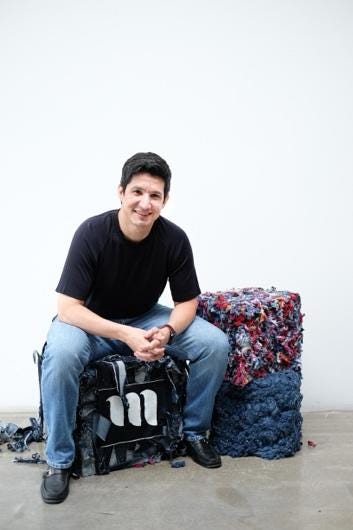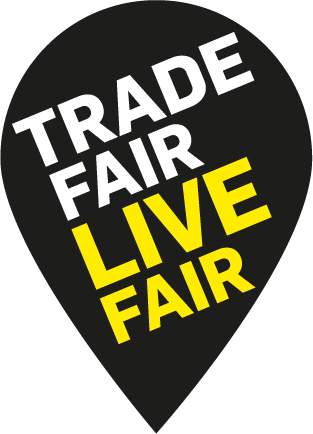JOIN OUR BOARD OF DIRECTORS
Fashion Revolution CIC is seeking new members to join our Board of Directors during a pivotal period of transition and strategic renewal. We are looking for leaders who share our values and are committed to supporting the long-term vision and sustainability of the organisation.
Recruitment is open to candidates globally, but due to regulatory compliance, we also seek candidates based in the UK specifically.
Please note that these are voluntary roles
About Fashion Revolution
We are the world’s largest fashion activism movement, mobilising citizens, brands, and policymakers through research, education, and advocacy. Our vision is a global fashion industry that conserves and restores the environment and values people over growth and profit.
About the Role – Treasurer
The Treasurer will support the effective governance and financial oversight of Fashion Revolution CIC. As we emerge from a period of organisational transition, the Treasurer will be a key figure in setting a strong foundation for our go-forward strategy.
This role involves guiding financial strategy, supporting oversight of systems and controls, and ensuring compliance with all relevant regulatory and funder requirements.
Key Responsibilities
Strategic
- Provide financial insight to support the charity’s strategic direction
- Ensure that financial planning supports the organisation’s goals
Financial Oversight
- Ensure timely and accurate financial reporting to the Board, including annual accounts and management reporting
- Oversee budget processes, financial controls, and policy development
- Lead on the appointment and engagement of auditors
- Work closely with the finance team to ensure sound day-to-day financial practices
Assets and Reserves
- Review and support investment and reserves policies
- Monitor the appropriate use and maintenance of the organisation’s assets
Governance
- Chair the Finance and Governance Sub-Committee
- Ensure the Board’s financial duties are understood and exercised properly
- Contribute to Board development, including annual review processes
General Director Responsibilities
- Actively contribute to strategic decision-making
- Ensure resources are used effectively and responsibly
- Uphold the values, reputation, and integrity of Fashion Revolution
- Participate in Board and subcommittee meetings, read relevant papers, and provide guidance using your expertise
Who We’re Looking For
We welcome expressions of interest from candidates with:
- Senior-level financial experience, ideally with Board or trustee exposure
- Knowledge of financial management in a charity, CIC, or not-for-profit context
- Familiarity with UK accounting and reporting requirements
- Strategic insight and a collaborative approach to governance
- A genuine commitment to our mission and values
About the Role – Board Member
This is a general Board Member role with a focus on strategic support and good governance. As we finalise our transition from a Community Interest Company (CIC) to a Charitable Incorporated Organisation (CIO), the new Board Member will contribute to building a stable, inclusive, and future-ready organisation.
We are particularly keen to hear from candidates who bring experience in at least one of the following areas:
- Strategic fundraising or philanthropic engagement
- Sustainable fashion or ethical supply chains
- Not-for-profit or mission-driven leadership
- Governance, particularly CIC to CIO transitions or membership-based models
Key Responsibilities
Strategic
- Contribute to shaping and overseeing the organisation’s strategic direction
- Offer constructive insight and support to the executive team and fellow Board members
Governance Oversight
- Help ensure the organisation meets its legal and fiduciary responsibilities
- Promote transparency, accountability, and inclusive decision-making
Engagement
- Represent Fashion Revolution’s mission, values, and objectives externally where appropriate
- Support Board development and help strengthen the organisation’s overall effectiveness
General Director Responsibilities
- Actively contribute to strategic decision-making
- Ensure resources are used effectively and responsibly
- Uphold the values, reputation, and integrity of Fashion Revolution
- Participate in Board and subcommittee meetings, read relevant papers, and provide guidance using your expertise
Time Commitment
We are currently completing a governance transition and laying the groundwork for a sustainable, forward-looking strategy. As such, the estimated time commitment is:
- At least five hours per week over the next six months (during the transition period)
- Thereafter, approximately 6–8 Board and subcommittee meetings per year, with periodic engagement with the executive team
Who We’re Looking For
We welcome expressions of interest from individuals with:
- Experience in at least one of the following:
- Strategic fundraising or philanthropic engagement
- Sustainable fashion or ethical supply chains
- Not-for-profit or mission-driven leadership
- Governance or legal structures (ideally including CIC to CIO transitions)
- A collaborative and strategic mindset
- A strong alignment with our mission and values
- Prior Board or trustee experience is helpful but not essential
Honorarium: £1,000 per year
How to apply
Please send your CV and a short covering note outlining your interest and relevant experience with the subject line ‘’Trustee’’ to recruitment@fashionrevolution.org. Applications will be reviewed on a rolling basis. The closing date for applications is August 7, 2025.
Fashion Revolution is an equal opportunity employer. We are particularly interested in hearing from candidates from under-represented groups, including women, disabled people, Black, Asian, and Minority Ethnic (BAME) communities.
Cada día, somos bombardeados con información sobre la crisis ambiental, social y cultural en la industria de la moda. Pero, ¿realmente estamos tomando acción o simplemente esperando a que las marcas y gobiernos lo hagan por nosotros? No se trata solo de comprar menos o reciclar más, sino de convertirnos en agentes de cambio que exigen responsabilidad y transparencia. Para comprender mejor cómo podemos hacerlo, entrevistamos a tres expertos del sector: Cecilia Manzur, Diseñadora y Modelista de Vestuario y Asesora de Imagen, Chile, y Alicia Mares, Corresponsal de Negocios de Moda en México y Latinoamérica para Fashion Network y Alfonso Martínez Equihua, Director General de Industrias Marves y Co Fundador re.colecto.
A través de sus perspectivas, reiteramos estrategias clave que cada consumidor puede implementar para impulsar transformaciones reales en la industria.
Dejar de Esperar Información: El Poder del Conocimiento
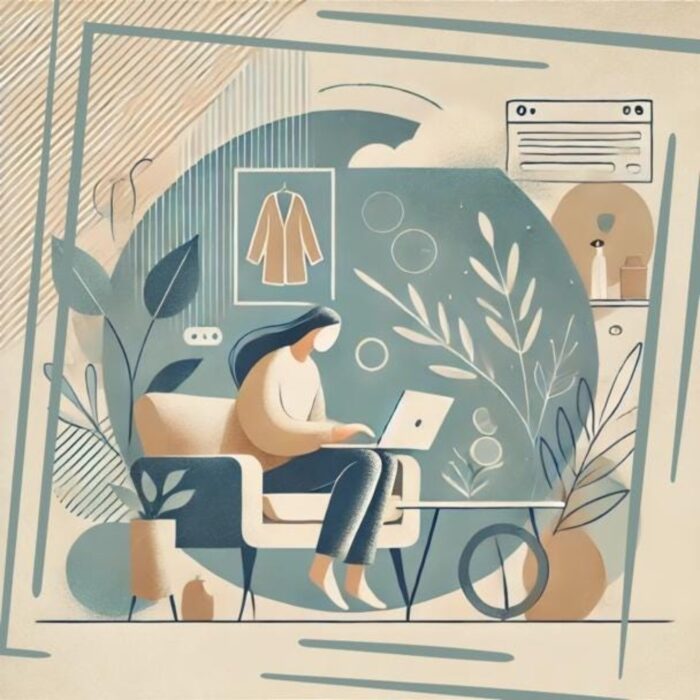
Cecilia Manzur enfatiza que uno de los primeros pasos para generar cambios es dejar de esperar que la información nos llegue sola. Como consumidores, debemos buscar activamente datos sobre marcas, procesos de producción y sostenibilidad. Preguntar en tiendas sobre sus políticas de reciclaje o fabricación, no solo nos da herramientas para tomar mejores decisiones, sino que presiona a las empresas a ser más transparentes.
Desde su experiencia como asesora de imagen, Cecilia también destaca que enseñar a otros sobre consumo responsable, selección de prendas de calidad y exploración de opciones, como la ropa de segunda mano, puede marcar la diferencia. Como diseñadora, considera que el cambio también debe venir de la industria, diseñando colecciones con materiales sostenibles y procesos de producción más éticos.
Por otro lado, Alfonso nos dice que “el consumidor tiene mucho más poder y responsabilidad en la industria de la moda de lo qué cree. Cada compra manda un mensaje al mercado, y las grandes marcas están escuchando”.
Redes Sociales: ¿Herramienta de Cambio?
Alicia Mares nos recuerda que en la era digital, los consumidores tienen un poder sin precedentes. Antes, los movimientos sociales requerían marchas y protestas; hoy, “ya no es de boca en boca, es de publicación en publicación”, nos dice. Sin embargo, advierte que este poder debe usarse con responsabilidad. Un mal uso de la información puede desacreditar esfuerzos genuinos y desviar la atención de los verdaderos problemas.
De igual forma nos comenta que además de ser una herramienta de denuncia y presión, las redes sociales también funcionan como una fuente inagotable de información y conocimiento. Ahora, desde nuestras redes sociales, podemos cuestionar a las marcas, compartir información sobre eventos, iniciativas, y apoyar a proyectos sostenibles, lo que dirige al consumidor a hacer compras más conscientes. La clave está en filtrar la información, verificar fuentes y compartir contenido que realmente aporte valor a la conversación, lo que generará transformación.

Asimismo nos dice que la propagación de campañas, iniciativas, testimonios de consumidores, etc. ha demostrado ser un motor de cambio en la industria. Cuando una marca es señalada por prácticas poco éticas, la presión mediática puede obligarla a modificar sus procesos. Pero del mismo modo, cuando una empresa implementa políticas responsables, los consumidores pueden amplificar ese mensaje, generando una demanda por productos y servicios alineados con la sostenibilidad; “un simple clic puede hacer muchísima diferencia”, nos dice Alicia.
De igual forma, resalta la importancia de participar activamente, por ejemplo al prolongar la vida útil de nuestras prendas a través de la reparación, el reciclaje y la compra de ropa de segunda mano. Esto no solo reduce el impacto ambiental, sino que envía un mensaje claro a la industria sobre la creciente demanda de alternativas sostenibles. Al respecto, Alfonso nos explica que re.colecto proporciona una oportunidad de mucho menor impacto al desechar nuestras prendas y presenta la oportunidad de darles una segunda vida.
Transparencia: El Vínculo Perdido entre Consumidores, Gobiernos y Marcas

Tanto Cecilia como Alicia coinciden en que la falta de transparencia y comunicación de gobiernos y marcas obstaculiza el avance hacia una moda sostenible. Cecilia nos habla sobre la Ley REP (Ley de Responsabilidad Extendida del Productor) en Chile, la cual incentiva a las empresas a implementar prácticas más responsables, otorgándoles puntajes adicionales en licitaciones y promoviendo la recolección de residuos. Por otro lado, Alicia nos comenta sobre iniciativas como la feria “Original”, que apoya a los artesanos, y la prohibición de pruebas cosméticas en animales en México, avances importantes, pero que su escasa difusión hace que pasen desapercibidos.
De igual modo, Alfonso estipula que “en México, aún falta camino en regulaciones que incentiven una industria textil más sostenible. Nos dice que “se habla de la responsabilidad extendida del productor”, pero que “también es clave la corresponsabilidad del consumidor” y que “la solución no está solo en las marcas ni en los gobiernos: está en una mayor conciencia sobre cómo elegimos, usamos y desechamos nuestra ropa”.
Por otra parte nos comenta que al demandar transparencia para producir responsablemente y sobre el uso de materiales más durables, las marcas seguirán escuchando y habrá un impacto positivo de mayor grado.
Si los gobiernos y marcas fueran más abiertos y transparentes sobre sus proyectos, acciones y políticas, se generaría una mayor conciencia en los consumidores. La comunicación efectiva y transparente no solo permitiría que las personas tomaran mejores decisiones, sino que también alentaría a más empresas a sumarse a las prácticas sostenibles, comenta Alicia y Alfonso agrega que “si hubiera más información clara sobre regulaciones y prácticas responsables, tanto de gobiernos como de marcas, los consumidores podrían tomar mejores decisiones y nos comenta que “la transparencia genera confianza y compromiso”.
La Petición Más Urgente para Marcas y Gobiernos
Si pudieran pedir una sola acción inmediata, Cecilia, Alicia y Alfonso tienen solicitudes claras. Cecilia señala la necesidad de regular la importación de textiles provenientes del norte, ya que, como bien se sabe, toneladas de ropa terminan en vertederos en el desierto sin ningún control. Implementar normativas más estrictas en este sentido demostraría un verdadero compromiso gubernamental con la sostenibilidad.
Alicia, en cambio, enfatiza que la clave está en la transparencia. Si las marcas y gobiernos no comunican lo que están haciendo (o lo que no están haciendo), los consumidores quedan en la oscuridad, sin herramientas para exigir mejoras reales.
Para Alfonso, el impulso hacia una forma de trabajar en donde productores y consumidores participen de forma activa en la economía circular es esencial, y destaca que “no basta con producir mejor, también debemos consumir mejor y reducir el desperdicio”.
No Esperes el Cambio, Sé el Cambio
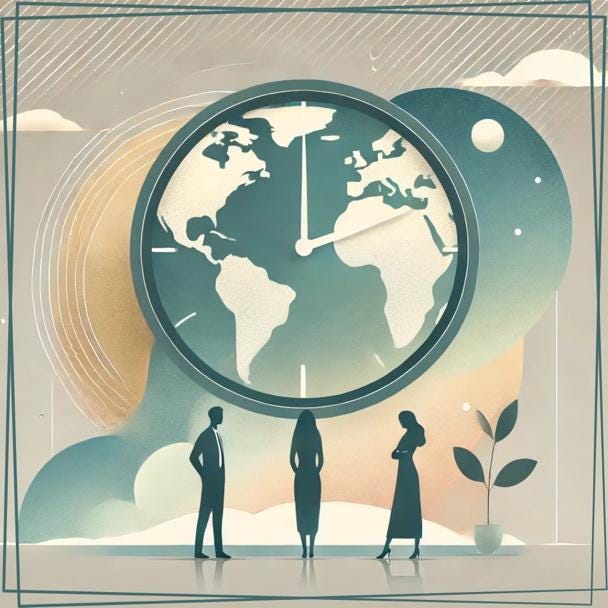
El futuro de la moda sostenible no depende exclusivamente de las marcas y gobiernos, sino también de la determinación individual de los consumidores. Desde buscar información activamente hasta exigir transparencia y apoyar iniciativas sostenibles, cada decisión cuenta. Dejar de esperar y empezar a actuar es el primer paso para transformar la industria textil y de la moda en una más ética y responsable y las redes sociales, cuando se usan de manera estratégica y fundamentada, pueden ser una de nuestras mejores aliadas en este camino; no sólo para denunciar y presionar, sino también para educarnos, compartir información valiosa y construir una comunidad consciente y comprometida con el cambio.
La pregunta es: ¿te quedas esperando o tomas acción?
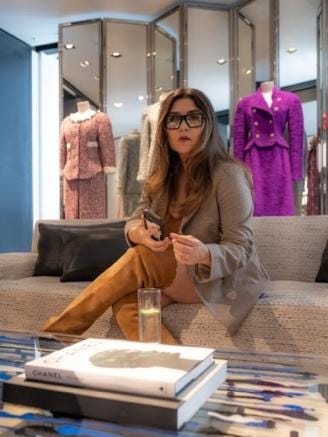 .
.
Alicia Mares, Corresponsal
de Negocios y Moda en México
y Latinoamérica para
Fashion Network
Cecilia Manzur, Diseñadora
, Modelista de Vestuario y
Asesora de Imagen, Chil
Alfonso Martínez Equihua
Director General de Industrias
Marves y Co Fundador de re.colecto
Por: Silvia Jiménez de la Mora, Consultora en Imagen y Guardarropa Sostenible, AICI CIC,
Directora del Comité de Sustentabilidad para AICI Global.
English
From Passivity to Action: How Can Consumers Demand More Responsible Fashion?
By: Silvia Jiménez de la Mora, Image and Sustainable Wardrobe Consultant, AICI CIC,
Director of the Sustainability Committee for AICI Global.
Every day, we are bombarded with information about the environmental, social, and cultural crisis in the fashion industry. But are we really taking action or simply waiting for brands and governments to do it for us? It’s not just about buying less or recycling more, but about becoming agents of change who demand accountability and transparency. To better understand how we can do this, we interviewed three industry experts: Cecilia Manzur, Costume Designer, Modeler, and Image Consultant, Chile; Alicia Mares, Fashion Business Correspondent in Mexico and Latin America for Fashion Network; and Alfonso Martínez Equihua, CEO of Industrias Marves and Co-Founder of re.colecto.
Through their perspectives, we reiterate key strategies that every consumer can implement to drive real transformations in the industry.
Stop Waiting for Information: The Power of Knowledge
Cecilia Manzur emphasizes that one of the first steps to generating change is to stop waiting for information to come to us. As consumers, we must actively seek out data about brands, production processes, and sustainability. Asking stores about their recycling or manufacturing policies not only gives us tools to make better decisions, but also pressures companies to be more transparent.
Based on her experience as an image consultant, Cecilia also highlights that teaching others about responsible consumption, selecting quality garments, and exploring options, such as secondhand clothing, can make a difference. As a designer, she believes that change must also come from the industry, designing collections with sustainable materials and more ethical production processes.
On the other hand, Alfonso tells us that “consumers have much more power and responsibility in the fashion industry than they think. Every purchase sends a message to the market, and big brands are listening.”
Social Media: A Tool for Change?
Alicia Mares reminds us that in the digital age, consumers have unprecedented power. Previously, social movements required marches and protests; today, “it’s no longer word of mouth, it’s publication after publication,” she tells us. However, she warns that this power must be used responsibly. Misuse of information can discredit genuine efforts and divert attention from the real problems.
She also tells us that in addition to being a tool for denunciation and pressure, social media also functions as an inexhaustible source of information and knowledge. Now, through our social networks, we can question brands, share information about events and initiatives, and support sustainable projects, which leads consumers to make more conscious purchases. The key is to filter information, verify sources, and share content that truly adds value to the conversation, which will generate transformation.
He also tells us that the spread of campaigns, initiatives, consumer testimonials, etc. has proven to be a driver of change in the industry. When a brand is called out for unethical practices, media pressure can force it to modify its processes. But similarly, when a company implements responsible policies, consumers can amplify that message, generating demand for products and services aligned with sustainability; “a simple click can make a huge difference,” Alicia tells us.
Similarly, she highlights the importance of actively participating, for example by extending the lifespan of our clothes through repairing, recycling, and buying secondhand clothing. This not only reduces the environmental impact but also sends a clear message to the industry about the growing demand for sustainable alternatives. In this regard, Alfonso explains that re.colecto provides a much lower-impact opportunity to discard our clothes and presents the opportunity to give them a second life.
Transparency: The Missing Link between Consumers, Governments, and Brands
Both Cecilia and Alicia agree that the lack of transparency and communication from governments and brands hinders progress toward sustainable fashion. Cecilia tells us about Chile’s Extended Producer Responsibility Law (REP), which incentivizes companies to implement more responsible practices, giving them additional points in bidding processes and promoting waste collection. Alicia also shares about initiatives such as the “Original” fair, which supports artisans, and Mexico’s ban on animal testing for cosmetics. These are important advances, but their limited publicity means they go unnoticed.
Similarly, Alfonso stipulates that “in Mexico, there is still a long way to go in regulations that encourage a more sustainable textile industry. He tells us that “there is talk of extended producer responsibility,” but that “consumer co-responsibility is also key” and that “the solution lies not only with brands or governments: it lies in greater awareness about how we choose, use, and dispose of our clothing.”
Furthermore, he tells us that by demanding transparency in responsible production and the use of more durable materials, brands will continue to listen and there will be a greater positive impact.
If governments and brands were more open and transparent about their projects, actions, and policies, greater awareness would be generated among consumers. Effective and transparent communication would not only allow people to make better decisions but would also encourage more companies to adopt sustainable practices, Alicia comments. Alfonso adds that “if there were more clear information about regulations and responsible practices, from both governments and brands, consumers could make better decisions.” He tells us that “transparency generates trust and commitment.”
The Most Urgent Request for Brands and Governments
If they could ask for a single immediate action, Cecilia, Alicia, and Alfonso have clear requests. Cecilia points out the need to regulate the import of textiles from the north, since, as is well known, tons of clothing end up in desert landfills without any control. Implementing stricter regulations in this regard would demonstrate a true government commitment to sustainability.
Alicia, on the other hand, emphasizes that the key is transparency. If brands and governments don’t communicate what they are doing (or what they aren’t doing), consumers are left in the dark, without the tools to demand real improvements.
For Alfonso, the push toward a way of working where producers and consumers actively participate in the circular economy is essential, and he emphasizes that “it’s not enough to produce better; we must also consume better and reduce waste.”
Don’t Wait for Change, Be the Change
The future of sustainable fashion depends not only on brands and governments, but also on the individual determination of consumers. From actively seeking information to demanding transparency and supporting sustainable initiatives, every decision counts. Stopping waiting and starting to act is the first step toward transforming the textile and fashion industry into a more ethical and responsible one. Social media, when used strategically and thoughtfully, can be one of our greatest allies on this path; not only to expose and pressure, but also to educate ourselves, share valuable information, and build an aware community committed to change.
The question is: do you wait or do you take action?
Off Paper: The Hidden Cost of Home-based Workers
By: Aastha Jain , member of Fashion Revolution India
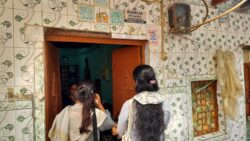 No Policies, No Records—42 million home-based workers remain systematically invisible, with approximately 19% engaged in apparel production. As a policy researcher with the Fashion Transparency Index Working Group between September 2024 and December 2024, I met several women stitching buttons and embroidering and overturning socks in Delhi’s dense colonies, revealing the mechanisms through which capitalist structures perpetuate exploitation, transforming homes into sites of economic negotiation.
No Policies, No Records—42 million home-based workers remain systematically invisible, with approximately 19% engaged in apparel production. As a policy researcher with the Fashion Transparency Index Working Group between September 2024 and December 2024, I met several women stitching buttons and embroidering and overturning socks in Delhi’s dense colonies, revealing the mechanisms through which capitalist structures perpetuate exploitation, transforming homes into sites of economic negotiation.
The informal sector has three archetypes: contractors, piece-rate workers, and self-employed workers. Their labour encompasses completing semi-finished apparel and accessories like bags, shoes, cushion covers, and bangles, assembling bindi packets, attaching buttons, applying trims, packaging, labeling, embroidery, and crochet.
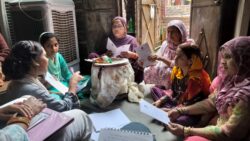 Fixed contractors connected to factories function as intermediaries who distribute work daily or weekly in different neighborhoods. Factories dictate compensation for the contractors. The contractors extract a 40-50% margin before redistributing wages. Piece rates demonstrate huge variability, fluctuating based on geographical location, distance from factories, labour demand, and skills scarcity—ranging from INR 1 ($0.012) to INR 70 ($0.83) per piece. The COVID-19 pandemic exacerbated existing vulnerabilities. Unlike other sectors experiencing recovery post-pandemic, this trade witnessed a wage decline. Contractors, who also tend to be migrant workers, often run away with the due amount. Those who stay nearby or in the same neighborhood as workers show cooperation and timely payment.
Fixed contractors connected to factories function as intermediaries who distribute work daily or weekly in different neighborhoods. Factories dictate compensation for the contractors. The contractors extract a 40-50% margin before redistributing wages. Piece rates demonstrate huge variability, fluctuating based on geographical location, distance from factories, labour demand, and skills scarcity—ranging from INR 1 ($0.012) to INR 70 ($0.83) per piece. The COVID-19 pandemic exacerbated existing vulnerabilities. Unlike other sectors experiencing recovery post-pandemic, this trade witnessed a wage decline. Contractors, who also tend to be migrant workers, often run away with the due amount. Those who stay nearby or in the same neighborhood as workers show cooperation and timely payment.
A shared space for home and work exposes profound gender-based contradictions. Women, responsible for domestic labour, are compelled to negotiate complex frameworks—first fulfilling family responsibilities, then pursuing work in the remaining time. Women decide whether they can accommodate more labour or not as per their domestic schedule. Many women are not allowed to move outside, rendering home-based work as a survival strategy. Work remains fundamentally precarious: no monthly guarantees, with labour oscillating between hectic periods and prolonged intervals of scarcity. The irregularity breeds systemic mistrust and hopelessness, compelling some to abandon this labour mode while others persist as a final economic recourse.
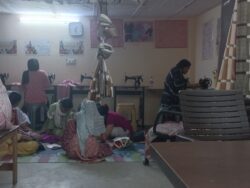 To meet their basic needs, workers try to maximise work, generating low piece-rate wages. Such compensation structures incentivize maximum labour extraction. Families, including children who spend substantial amounts of time with mothers, become integrated into production processes. The fundamental contradiction emerges: how can corporations proclaim freedom from forced or child labour when entire communities are economically coerced into such labour arrangements?
To meet their basic needs, workers try to maximise work, generating low piece-rate wages. Such compensation structures incentivize maximum labour extraction. Families, including children who spend substantial amounts of time with mothers, become integrated into production processes. The fundamental contradiction emerges: how can corporations proclaim freedom from forced or child labour when entire communities are economically coerced into such labour arrangements?
In Delhi, workers inhabit densely populated neighborhoods characterized by open sewage systems, intermittent electricity supply, water scarcity, and inadequate ventilation. Typical living rooms(a 10 x 10 feet space)egregiously contradict International Labour Organization (ILO) conventions mandating workspace requirements. Workers absorb additional economic burdens, including electricity costs, healthcare expenses, and workspace rental, which remain strategically unaccounted for in supply chain calculations.
“Bindi sticking impacts eyesight, back pain, and exposure to chemicals severely. Another such hazard is from clothes made with chemical dyes. During extreme heat in summer, dyes stick to hands causing skin infections. No provision of safety gears, social security schemes, healthcare provisions worsen the worker’s conditions.” – Subadhra Pandey, Representative SEWA in Delhi
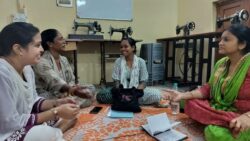 Unionization of informal workers confronts multifaceted obstacles: absence of direct employer contact, lack of governmental protective mechanisms, and the invisibility of home-based labour. Brand identification by workers and the union is impossible within this fragmented production ecosystem. Merely 0.25% of workers comprehend their position within broader supply chains, mentions Subadhra. The proliferation of counterfeit products further obscures potential accountability mechanisms.
Unionization of informal workers confronts multifaceted obstacles: absence of direct employer contact, lack of governmental protective mechanisms, and the invisibility of home-based labour. Brand identification by workers and the union is impossible within this fragmented production ecosystem. Merely 0.25% of workers comprehend their position within broader supply chains, mentions Subadhra. The proliferation of counterfeit products further obscures potential accountability mechanisms.
SEWA is a union of 2.9 million informal workers. SEWA in Delhi serves 70,000 workers out of which 7,000 work in the garment industry as home-based workers. Along with other South Asian organisations, the union has developed a transparency tool called Wage Card to document monthly work and negotiate for fair wages. This tool records transactional details, work performed, payments due, and brand associations.
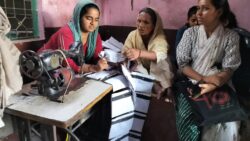 The fundamental struggle demands systemic recognition. Unions articulate comprehensive demands: joint employer responsibility, profit redistribution, social security provisions, regular work, minimum wage guarantees, and most importantly ratification of international labour conventions- C177.
The fundamental struggle demands systemic recognition. Unions articulate comprehensive demands: joint employer responsibility, profit redistribution, social security provisions, regular work, minimum wage guarantees, and most importantly ratification of international labour conventions- C177.
The invisibility of home-based workers reinforces profound epistemic violence—where labour is essential yet systematically marginalized. Most workers do not even acknowledge themselves as workers but as homemakers, wives, or mothers. Their work remains unacknowledged by governments, employers, and manufacturers alike. The hidden costs—including electricity, tools, healthcare, family labor, and unpaid wages—create a perception of cheap production, enabling brands to increase profits by transferring economic burdens to the working class of producing nations.
–
The article is written by Aastha Jain, a visual designer and researcher. She is also a member of Fashion Revolution India. The insights are based on discussions with Subadhra Pandey, Representative SEWA in Delhi, and home-based workers from Delhi. For contact, reach at: aasthajn29@gmail.com
On Paper: Worsening Conditions of Labour in India’s Garment Sector
By: Aastha Jain , member of Fashion Revolution India
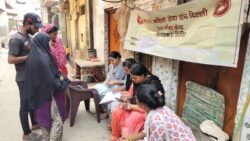
The conditions of workers in producing nations like India reveal a stark contradiction: despite increasing international legislative protections, workers’ lived experiences continue to deteriorate. The acts of intensifying production and alienation of labour have left the workers isolated with stagnant minimum wages and growing monopolization of brands and suppliers. During my time as a policy researcher with the Fashion Transparency Index Working Group between September 2024 and December 2024, I discussed with the union leaders and researchers, the conditions of the garment workers on the shop floor, and the conditions of piece-rate home-based workers in India.
Rukmini VP, President of Garment Labour Union(GLU) highlights that amongst 72 sectors across industries in India, only 4 sectors namely Garment, Leather, Spinning, and Textile have the lowest wages; INR 8,000 ($95) – INR 12,000 ($143) per month (p/m). As per the national law, minimum wages have to be revised every 3-5 years, yet it has stagnated for over a decade in many states. Even if it gets revised its implementation is rare, often retaliated by the factory owners with court cases.
Labour requiring an average of 9 to 11 hours per day (which contradicts Indian Labour Law that limits to 48 hours a week), and paying less than $100 p/m, can increase up to 14 to 16 hours per day during peak seasons.“Workers are allowed a maximum of 30-minute break, and even this is contingent on meeting punishing production targets of 150-200 garment pieces per hour,” says Rukmini VP. Rampant harassment, caste-based discrimination, poor healthcare, and childcare facilities, are further deteriorating the physical, social, and mental conditions of a worker.
“Workers are allowed a maximum of 30-minute break, and even this is contingent on meeting punishing production targets of 150-200 garment pieces per hour,” says Rukmini VP.
The gendered nature of the workforce amplifies these economic challenges. A predominantly female workforce (around 90%) migrates across states to manufacturing districts, being first-generation industrial workers. These migrant workers face heightened risks of harassment, possess weak negotiation power, and experience job insecurity. Underage girls between 14 and 15 years enter factories using falsified age certificates.

In addition to this exploitation which leaves individual workers vulnerable, organising resistance is also made difficult. According to interviewed union representatives, In India, less than 4% of the working class in the garment industry are part of unions. Additionally, they state that the brands, and factories employ extreme forms of tactics to suppress workers from organizing, including targeting the workers, surveillance, economic intimidation, creating yellow trade unions, stopping purchase orders (stop sourcing from that vendor), terminating employment, and threatening organizers, amongst others.
Paradoxically, increasing compliance has created new forms of exploitation. The documentation process has become so complex that specialized firms now solely manage supplier paperwork. Small manufacturers unable to navigate this bureaucratic labyrinth are being systematically eliminated, establishing a monopoly on large manufacturers. The legitimacy of submitted documentation also remains highly non-reflective of the conditions. It remains unreliable due to sole commitment to paper as a tool for auditing. There are no third-party audits or unplanned visits to verify the information shared in the submitted documents. Factory visits are meticulously planned, with workers threatened to maintain silence. The auditors do not engage with the unions who could bear testimony to the true working conditions.

Brands have transferred their responsibility and accountability of ensuring decent working conditions to the suppliers without transferring actual ownership or profits: a sublime act of class manipulation. This paper trail becomes a shield, protecting brands from accountability while maintaining the illusion of ethical production. Workers remain trapped in a system where documentation matters more than real working conditions.
Paper emerges as an instrument of oppression, simultaneously serving as a survival mechanism for the oppressed. Entrenched in their accumulated wealth, the ruling class wields economic instruments, crafting an illusion of autonomy while sharpening the blades of systemic exploitation. Combating global capitalism’s inherent transnational nature, the struggle demands international solidarity. Amidst poor implementation of local state mechanisms, trade unions increasingly rely on global support to negotiate effectively. Their core demands remain fundamental: joint employer responsibility, living wages, union recognition, regular unannounced inspections, and dignified working conditions.
——
The article is written by Aastha Jain, a visual designer and researcher. She is also a member of Fashion Revolution India. The insights are based on discussions with Rukmini VP, Garment Labour Union, Nandita Shivkumar, labour Rights Researcher, and Thivya Rakini, Tamil Nadu Textile Commons Unions. For contact, reach at: aasthajn29@gmail.com
By: So Young Park – Country Coordinator at Fashion Revolution South Korea
We all have old T-shirts with stretched or frayed necklines from countless days of wear and tear. I have clothes tucked away in the back of my wardrobe that I occasionally pull out to reminisce. Volunteering with Fashion Revolution for the past three years has taught me that fashion activism isn’t just about buying clothes with a “sustainable” label. Instead, it’s about digging through your wardrobe, pulling out old clothes, and finding ways to breathe new life into them. I waited until a hole the size of my thumb appeared in a favorite shirt, figured out how to sew it up, covered the hole with thread in my favorite color, and now enjoy the satisfaction of wearing it every time.
My journey into sustainable fashion began in 2020 in a small Batik studio in Jakarta, where I met passionate textile enthusiasts. There, I learned about the craft, history, rituals, and the deep connections between textiles, communities, and respect for nature. This experience profoundly shifted my perspective on life, extending far beyond textiles and fashion. I came to understand that clothing is more than just fabric on our bodies; it represents an ongoing dialogue with the people who make it. It is not something disposable to be taken and thrown away.

In 2021, while traveling through the beautiful landscapes of West Java, I witnessed a polluted river filled with industrial waste and a mountain littered with discarded clothes. It was a shocking sight. My nine-year-old son looked at me and said, “Mum, we have to do something for the planet.” His words stayed with me, and I began searching for ways to make a difference. Together with the dedicated members of Fashion Revolution South Korea, I’ve been volunteering to create digital campaigns that raise awareness about the complex fashion supply chain and its social and environmental impacts. These efforts include an exhibition called ‘Sa-o-ot (Love Clothes Last)’, which highlights the stories of people who have cherished their clothes for years, and translating and distributing the Fashion Transparency Index.
My nine-year-old son looked at me and said, “Mum, we have to do something for the planet.” His words stayed with me, and I began searching for ways to make a difference.

Through translation projects, I’ve met an incredible range of people—fashion designers, students, beauty industry researchers, educational planners, ESG consultants, and others—who have all said that participating in translation and campaign efforts raised their awareness. They expressed that the Fashion Transparency Index helped them understand industry changes and identify areas in need of improvement.
Year after year, the data in the report highlights key issues, revealing both progress and persistent challenges. The fashion industry’s impact varies profoundly across countries, often with devastating consequences. As detailed in the report, fashion can mean vastly different things depending on where you are: from glamorous runway shows to disposable trends that exploit vulnerable communities. In some countries, fashion is tied to women’s rights and freedoms. In others, it’s synonymous with sacrificing children’s education, clean water, and safe working conditions in favor of profits. Each country faces its unique challenges and issues to address within the fashion industry. South Korea, as one of the leading countries in the fashion industry, is no exception to these challenges including the struggles faced by small and medium-sized enterprises (SMEs) due to the weakening of the domestic production base. 
Despite these challenges, there is a universal set of values and directions we must pursue. We must recognize that these issues are not merely obstacles to overcome but opportunities to serve as turning points toward a sustainable future. On Volunteer Day, we honor the countless individuals who dedicate their time and effort to these principles. May their contributions fuel the growth of a just and green transition, paving the way for a more sustainable and equitable future.
The most anticipated and much-awaited event in VegFest 2023 is the VegFest Runway. A sustainable fashion show that has become a highlight of the festival. This year’s event resonated with creativity and resilience even in the face of a tropical storm. It showcased how fashion can contribute to preserving the environment and saving it from the climate crisis.
The VegFest Runway captivated a blend of innovative designs from three visionary fashion designers and a celebrity stylist. Together, they illustrated the impactful mantra of recycling, reusing, and reducing or the 3Rs. Through these compelling collections, the 3Rs define modern sustainable fashion.
A Showcase of Creativity and Sustainability
The first collection was called “Simply Trashion.” It captivated the audience with its transformative use of everyday recyclable materials. The designer turned empty plastic wrappers into stunning pieces. Shredded rice sacks were also used. They challenged conventional norms about waste by incorporating repurposed fabrics.
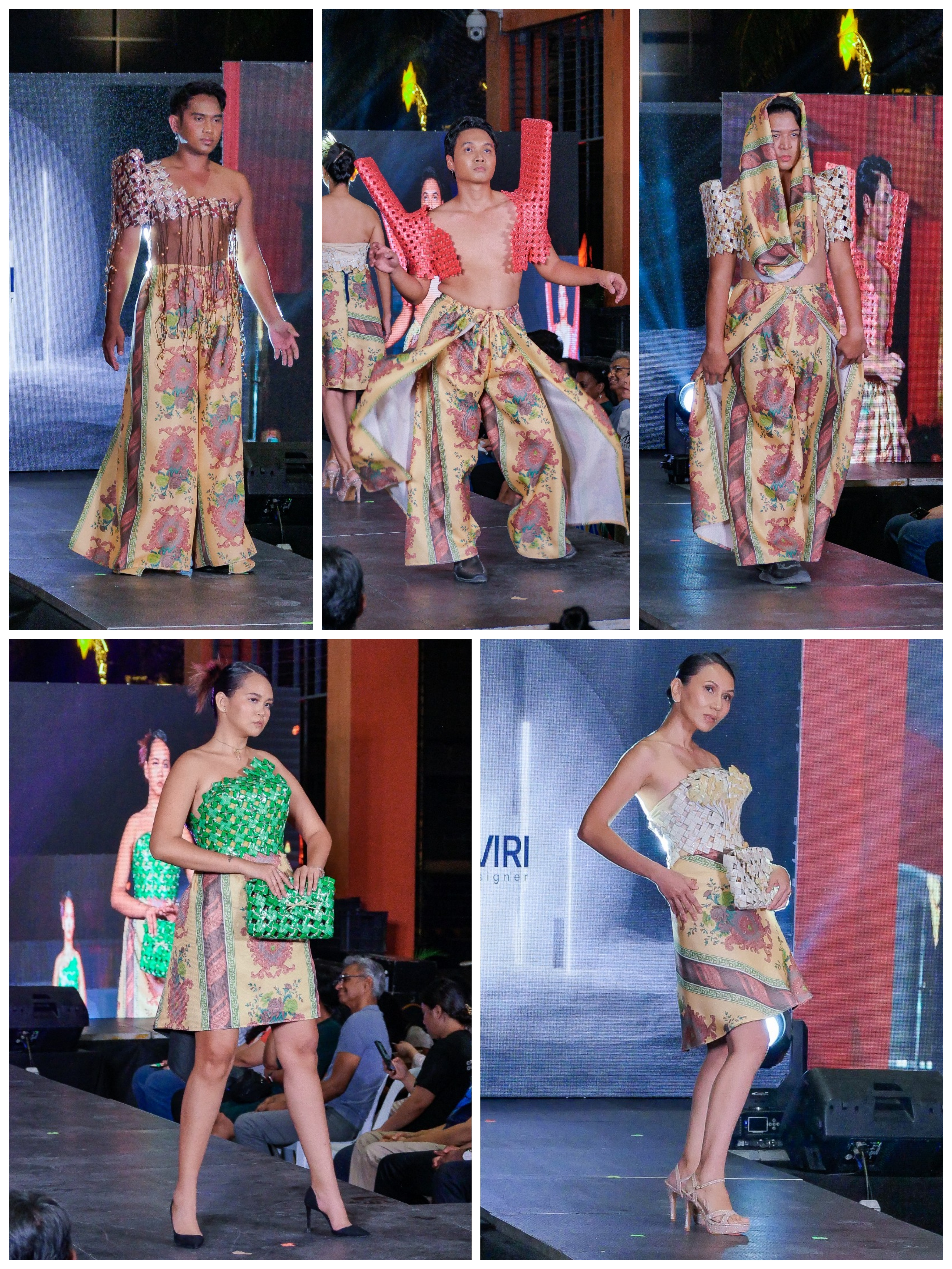
Leby Le Moría followed with a profound presentation. The attendees were treated to a collection that embodied years of introspection. The notion that vulnerability can be a source of strength is an inspiration. Each piece from her collection represented a chapter of her journey. Intricately woven with humanism and creativity.
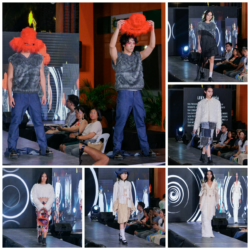
Next in line is Twinkle Ferraren’s Style Isle. The tropical landscapes of the Philippines influenced here we’ll renowned island wear designs. Putting together local artisans and indigenous tribes to encapsulate Filipino artistry. Ferraren’s collection showcased the rich Filipino heritage, and sustainably sourced textiles and accessories.
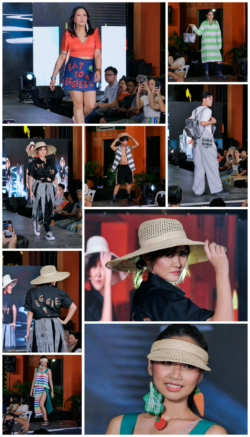
The show’s pulse quickened with celebrity eco-stylist and author Miss Kayce. She highlighted the vegan statement collection in advocating for positive change. Miss Kayce inspired the volunteer models to mix creatively and match pieces from their existing wardrobes. Aligned to their fashion choices with a vegan philosophy. A philosophy while promoting conscious consumerism.
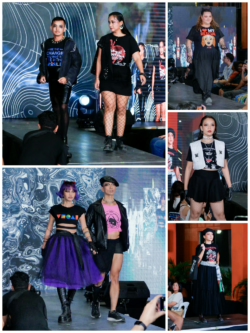
A Spotlight on Emerging Talents
The next day of VegFest 2024 is dedicated to students from SoFA Design Institute. They presented their unique street wear creations on the runway. Their instructor, Irene Grace Subang, guided their creativity to new heights. These budding designers utilized textile scraps donated by Barrios Studios.
Three esteemed experts in sustainable fashion judged the students. The judges are Prince Jimdel Ventura of Wear Forward, Buena Sawit of Barrios Studios, and celebrity stylist author Miss Kayce. They judged the students’ efforts across three categories: Best in Upcycled Construction, Most Innovative, and Best Collection. Additionally, the audience had the chance to vote for their favorite, culminating in an exhilarating People’s Choice award.
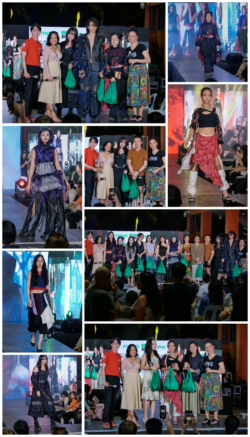
Embracing Eco-Consciousness
The VegFest Runway 2024 persevered to continue despite the looming threat of tropical storm Man-Yi. A powerful reminder of the fashion industry’s potential to drive environmental awareness. It served as a platform for creative expression and also as a conduit for inspiring actionable change.
VegFest Pilipinas, in collaboration with Fashion Revolution Philippines, reiterated its commitment to sustainable fashion. Leaving an indelible mark on the attendees and participants alike. The event successfully merged the worlds of fashion, environmentalism, and cultural heritage. It promoted a collective consciousness toward a more sustainable future.
As the final curtain fell, it was clear. The VegFest Runway has once again proved that style and sustainability can walk hand in hand. Where change is more than envisioned but it’s being woven into the very fabric of our lives.
IT’S TIME FOR FASHION BRANDS TO PUT THEIR MONEY WHERE THEIR EMISSIONS ARE
Fashion Revolution, the world’s largest fashion activism movement, is at Climate Week NYC 2024 with a clear message: fashion is fueling the climate crisis, and major fashion brands must urgently put their money where their emissions are.
We’re calling on major fashion brands to invest at least 2% of their revenue in a fair transition away from fossil fuels – like coal – to renewable energy sources – like wind and solar – to power fashion’s supply chain in a clean way.
Fashion is one of the most polluting industries on the planet, with fossil fuels burned at every stage of production. The industry alone is set to overshoot the 1.5°C limit by 50%, doubling emissions rather than halving them as the science is crying out for. Frequent climate catastrophes, like extreme heat, flooding, and droughts are devastating the livelihoods of workers across global garment supply chains, with extreme weather estimated to cost nearly one million jobs by 2030.
Fashion Revolution’s new report, What Fuels Fashion? reviewed 250 of the world’s largest fashion brands and retailers and ranked them according to their level of disclosure on climate and energy-related data in their operations and supply chains. The findings revealed that major fashion brands aren’t doing enough to cut fossil fuel use in their supply chains. 86% of major fashion brands lack A PUBLIC coal phase-out target, and only 3% disclose the level of financial support provided to supply chain workers affected by the climate crisis.
By investing at least 2% of their revenue into clean, renewable energy and upskilling and supporting workers, fashion could simultaneously curb the impacts of the climate crisis and reduce poverty and inequality within their supply chains. Climate breakdown is avoidable because we have the solution – and big fashion can certainly afford it.
WE ARE CALLING ON
- Policymakers to enhance regulation
- Investors to fund and co-fund renewable energy and decarbonisation projects
- Citizens to use their voice- email major brands and retailers and call on them to invest at least 2% of their annual revenues into their decarbonisation and Just Transition efforts
- Civil society, academia, journalists to leverage data and findings to scrutinise and verify the public claims made by brands
Big fashion can no longer mask its lack of decarbonisation progress with vague, insufficient targets and pilot projects that fail to benefit most of the supply chain. The need for system change is undeniable. It’s time for brands to put their money where their emissions are.
You can read the report here. Email your brands here.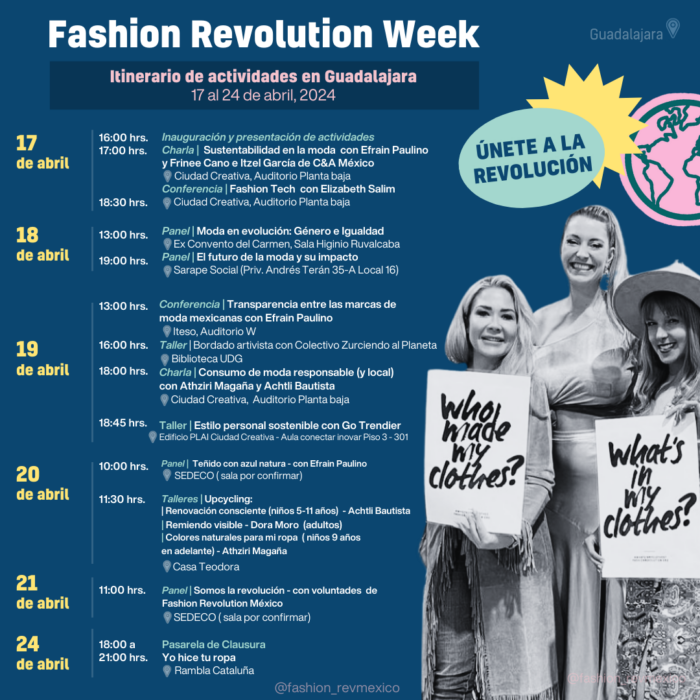 Este 17 al 24 de abril en Guadalajara, Jalisco estará sucediendo algo único!
Este 17 al 24 de abril en Guadalajara, Jalisco estará sucediendo algo único!
Te invitamos a vivir un evento multisede, en el cual podrás conocer de distintas maneras, cómo se puede ser parte de la revolución de la moda, esta de la que tanto se habla y a veces creemos que es totalmente ajena a los que no son diseñadores o marcas de moda.
En este evento conmemorativo por los 10 años de nuestro movimiento, podrás descubrir lo fácil que es ser parte, sin saber nada de diseño o del mundo del fashionismo.
Descubre aquí todas las actividades día por día , y por si quedara alguna duda, puedes seguirnos en Instagram y Facebook, donde estaremos compartiendo todos los detalles de esta increíble semana.
Día 1 – Miércoles 17 de Abril
- Inaguración 4:00 pm
Comenzaremos la semana de actividades con una colaboración irrepetible en Ciudad Creativa Digital:
Además del corte de listón te compartiremos todos los detalles sobre el evento, las sedes, los ponentes y todas las sorpresas que te esperan por ser parte de la Revolución!
- Conferencia: Introducción a la Moda Ética 5:00 pm Una de las marcas pioneras en sustentabilidad en México: C&A, nos acompañará para darnos una introducción a este tema, tan sonado como controversial.
- Conferencia: Fashion Tech 6:30 pm
De la mano de la líder en Tecnologías relacionadas a la sustentabilidad en Jalisco: Elizabeth Salim.
Pregunta por el Auditorio de la planta baja
¡Evento gratuito! ¡Registrate en
Mapa para llegar
Día 2 – Jueves 18 de Abril
Panel: Moda en evolución, género e igualdad 1:00 pm
Nuestros amigos de Igualdad Sustantiva Jalisco nos ayudarán a crear un espacio donde se pueda poner sobre la mesa el cómo la moda tiene una influencia en las nuevas y no tan nuevas perspectivas de género en Jalisco y en el mundo. Y lo mejor, en uno de los recintos mas cool de la Ciudad: el ExConvento del Carmen (pregunta por la Sala Higinio Ruvalcava)
¡Evento gratuito! ¡Registrate en
Mapa para llegar
Panel: El futuro de la moda y su impacto – 7:00 pm
Un grupo de mujeres emprendedoras y pioneras en la Moda sustentable, nos hablarán, desde distintas trincheras, sobre las últimas tendencias y la relación de este tema que tanto suena últimamente con temas como la cultura, el medio ambiente y la circularidad en la zona mas cool de la ciudad a unas cuadras de Avenida Chapultepec!
¡Evento gratuito! ¡Registrate en
Mapa para llegar
Día 3. – Viernes 19 de Abril
Conferencia: Transparencia entre las marcas de moda mexicanas con Efrain Paulino. 1:00pm
El ex coordinador de Fashion Revolution México y experto en Transparencia en la moda, dará la oportunidad a toda la comunidad ITESO para conocer cómo es que se puede ser tener prácticas más transparentes, así como usar eso a su favor en la hora de posicionar y promocionar una marca. Aunque es un evento dentro de la universidad, está abierto a todo Público. No olvides pedir tu QR de acceso al ITESO, enviando tu registro de Event Brite al Instagram de Modas Iteso.
Pregunta por el Auditorio 405 y 406 del Edificio W
¡Evento gratuito! ¡Registrate en
Mapa para llegar
Día 3. – Viernes 19 de Abril
Taller | Bordado artivista con Colectivo Zurciendo al Planeta 4:00pm
Zurciendo el Planeta es una colectiva artivista, que organiza eventos de Activismo ecológico mediante el bordado, y en el marco de nuestra FRW abrirá sus puertas para compartir toda su experiencia e invitar a hacer Artivismo, una actividad clave para ser Revolucionario, así que no te la pierdas!
Será en la terraza del piso 4 de la Biblioteca UDG!
¡Evento gratuito! ¡Registrate en
Mapa para llegar
Día 3. – Viernes 19 de Abril
Charla : Consumo de moda responsable (y local) 6:00pm
Dos mujeres con proyectos que, desde su propia perspectiva profesional sobre la Sustentabilidad: Athziri Magaña de Biosis Lab y Achtli Bautista de Ach+ , nos compartirán el sin fin de posibilidades que existen para que , aún sin ser diseñador ni estudiante de moda, podamos adquirir hábitos y formas de consumir más responsables. Si quieres ahondar en el mundo de la moda Eco, no te la puedes perder!
Pregunta por el Auditorio de la planta baja.
Evento gratuito! ¡Registrate en
Mapa para llegar
Día 3. – Viernes 19 de Abril
Taller : Estilo personal sostenible con Go Trendier – 6:45 pm
Go Trendier! la plataforma número uno de ventas de Segunda Mano, se suma a nuestro cartel de eventos para impartir un taller que te ayudará a construir tu propio guardaropa de una manera más sostenible, entendiendo desde la raíz el concepto de Circularidad y su experiencia como negocio y pioneros en innovación.
Pregunta por el Aula conectar inovar Piso 3 – 301
Evento gratuito! ¡Registrate en
Mapa para llegar
Día 4. – Sábado 20 de Abril
Panel : Teñido con azul natural: alga espirulina- con Efrain Paulino – 10:00 am
El azul es uno de los colores más bellos, sobre todo por que nos recuerda a la tierra, te imaginas teñir la moda con azul natural? cómo, con qué elementos y sobre qué superficies? descúbrelo todo de la mano de este grupo de académicos que están investigando como trabajar con el alga espirulina para encontrar distintas tonalidades de este bello color.
Agradecemos a las Secretarías de Medio ambiente y Desarrollo Económico por darnos este espacio en la colonia más cool del mundo!
(Pregunta por la Sala por confirmar)
Evento gratuito! ¡Registrate en
Mapa para llegar
Día 4. – Sábado 20 de Abril
¡Talleres de Moda Sustentable para toda la famila! – 11:30 am
Upcycling: renovación consciente para niños Enfoque niños 5-9 años acompañados de un adulto. Con Achtli Bautista – Aprende a darle nueva vida a tus prendas en familia y de una manera fácil y circular, desde el toque de una de las marcas de Upcycling más originales en Jalisco: Ach +.
Costo de recuperación de $80 pesos
Remiendo visible – Dora Moro (adultos) de TejeDora – Aprende a bordar y elegir los diseños más adecuados para tus prendas , de la mano de una de las pioneras en arte textil y una talentosísima maestra.
Aportacion voluntaria. Llevar una prenda rota o manchada para reparar con bordado
Colores naturales para mi ropa para adolescentes de Enfoque niños 9 años en adelante, con Athziri Magaña – Conoce formas de teñir tu ropa de la manera más original y sustentable, con elementos naturales que además puedes conseguir fácilmente en nuestro país, de la mano de Athziri, quien trabaja de la mano de artesanas.
Los asistentes deben llevar una playera de algodón que deseen teñir.
Costo de recuperación de $100 pesos
Evento con costo de recuperación
Registrate en
Mapa para llegar
Día 5. – Domingo 21 de Abril
Panel : Somos la revolución – con las voluntades de Fashion Revolution México. – 11:00 am
Conoce nuestro movimiento, y cada paso que hemos dado desde su nacimiento en el sur del país y cómo lo ha ido recorriendo hasta llegar con esta propuesta de evento a Guadalajara, además de conocer qué se viene en un futuro para la moda sustentable en nuestro país!
(Pregunta por la Sala por confirmar)
Evento gratuito! ¡Registrate en
Mapa para llegar
Día 6. – Miércoles 24 de Abril
Pasarela de Clausura: Yo hice tu ropa 6:00 pm
Gracias a Bajío Moda por compartir su filosofía de trabajo, inspirándonos a organizar esta Pasarela al aire libre y de acceso a todo público, justamente para acercar el mensaje de que la moda es para todxs, acompáñanos en la Rambla Cataluña (Av. Juarez en medio de de la rectoría de UDG y el Templo Expiatorio ).
The new year is a great time to set personal goals, reflect on the changes you want to make in your life and commit to making a positive impact on your wellbeing, the environment and your community. We may not be able to solve fashion’s BIG problems on our own. But every small step matters. Whether you want to transform your own shopping habits, learn some practical skills or take part in local community action, below you can find 24 ideas for fashion resolutions to set for 2024.
1. Learn to sew
Have you always wanted to make your own clothes? Now is the time to learn! Making your own clothes has many benefits; you form a connection with the item meaning you’re more likely to care for it properly and keep it for longer, you engage in slow fashion by making something to last and avoiding microtrends, and you gain a deeper understanding of how clothes are made which helps you value them more.
2. Enrol on our online course
Want to learn more about sustainability and fashion, but aren’t sure where to start? Our free online course with Future Learn is the perfect introduction to sustainable fashion. You can enrol in the free 4 week course here.
View this post on Instagram
3. Learn basic mending and repair techniques
Basic mending skills go a long way to help you make the clothes you love last that bit longer. In our culture of disposability, repairing our clothes is a revolutionary act; say no to throw away fashion this year and learn to mend!
4. Care for your clothes properly
Do you find yourself shrinking your favourite jumper or fading your graphic t-shirts? Make a conscious effort this year to learn how to care for your clothes properly. Always read the care label before washing your clothes and take time to follow the recommendations given – your clothes will thank you for it!
5. Join your local Fashion Revolution team
Are you looking for a community of like-minded people to collectively take action with, to transform the fashion industry? Your local Fashion Revolution team is a great place to start! With teams in over 75 countries worldwide, you can connect with the movement wherever you are. Find your local country team here.
Can’t find a team in your area? Get in touch to express your interest in forming a voluntary team in your local community.
6. Challenge yourself to only buy second hand items this year
Shopping second hand is one of the best ways to reduce your environmental impact and keep pre-loved clothes in circulation for longer. Platforms like Vinted, Depop and Ebay make it easier than ever to refresh your wardrobe in a more sustainable way. This year, challenge yourself to embrace thrifting and only buy second hand items. You’ll be surprised at the hidden gems you can find in a charity shop!
7. Support or join a grassroots organisation
Want to really make an impact in 2024? Look out for local volunteer opportunities with grassroots organisations working on the ground to improve the conditions for the people who make our clothes.
8. Learn how to knit or crochet
Pick up a new skill and learn to knit or crochet this year. Like sewing your own clothes, engaging with crafts like knitting and crochet helps build a closer connection to your wardrobe and makes you appreciate the time and skill that goes into making uour favourite knitwear. From jumpers, skirts and dresses to handbags, hats and scarves, the options for a new creative project are endless!
9. Read a book on sustainable fashion
Reading more books is a common New Year’s resolution, so why not add a book on sustainable fashion to your 2024 reading list? Some recommendations from the Fashion Revolution team include:
The Anti-Capitalist Book of Fashion by Tansy Hoskins
10. Shop from your own wardrobe first
Do you want to try and curb your consumption? Make it a habit to shop from your own wardrobe before you go out and buy anything new (or new to you!). Regularly reminding yourself of what you already own can help prevent unnecessary purchases. Get creative and experiment with what you have. Remember: the most sustainable garment is the one already in your wardrobe.
11. Prioritise longevity and invest in timeless pieces
When you absolutely have to buy something brand new, prioritise longevity and invest in timeless pieces that will last a lifetime. Before clicking checkout, be honest and ask yourself if the item you’re buying aligns with your personal style or if it’s just a microtrend. Only buy something you can see yourself wearing time and time again, for years to come.
12. Stop giving in to impulse buys
Do you often find yourself splurging on trendy new items that soon lose their sparkle and end up discarded at the back of your wardrobe? You might be impulse shopping. It’s a tricky habit to break but there are ways to manage it: Always give yourself at least 24 hours to think about a purchase before you commit to buying it and unsubscribe from brand emails to avoid marketing tactics that create a false sense of urgency.
13. Try a no new clothes challenge
If you really want to challenge yourself in 2024, try to avoid buying any clothes at all! Many people already own more than enough clothes, with the majority of them hardly ever being worn. WRAP found that the average UK adult has 118 items of clothing in their wardrobes – 26% of which were unworn for at least a year.
View this post on Instagram
14. Do a closet audit & clear out consciously
Starting the new year with a closet audit is a great way to take stock of what you already own and bring old pieces back into circulation. Making a note of what’s hidden in your wardrobe can help you shop more consciously, ensuring new pieces pair with existing items and avoiding duplicates. If you do decide to dispose of any items, please do so responsibly.
15. Become a proud outfit repeater
Your clothes deserve to be worn more than once! Banish the stigma and become a proud outfit repeater. When you put together an outfit that makes you feel great, snap a photo to refer back to. Soon you’ll have a catalogue of your favourite fits and you’ll never again be left with “nothing to wear”!
16. Normalise borrowing clothes from friends and family
Practise circular fashion principles this year and borrow clothes from your friends and family members. Next time you need a new outfit for an event or special occasion, see if your friends can lend a hand before hitting the shops. This can be especially helpful if you’re participating in a no new clothes challenge – just remember to ask first…
17. Give rental a try
Continuing the theme of circular solutions, try renting! Renting clothes is a great way to experiment with new styles and impress at special occasions without breaking the bank. As renting gains popularity, there are plenty of platforms to explore, including; By Rotation, Hurr and Wear My Wardrobe Out.
18. Support garment workers by signing petitions and donating to organisations on the ground
Show up for the people who make our clothes by engaging with campaigns that are fighting for fair pay and better working conditions. Stand in solidarity by signing petitions, spreading the word on social media and donating to organisations on the ground.
View this post on Instagram
19. Hold brands accountable by using social media and email
Engage in online activism and hold brands accountable by asking questions like #WhoMadeMyClothes and #WhatsInMyClothes. It’s bad business for brands to ignore their customers, so make your voice heard and demand better in 2024!
20. Talk to friends and family members about sustainable fashion
At Fashion Revolution we believe that change starts with a conversation. One of the simplest ways we can begin to transform the fashion system is by talking to our friends and family members about sustainable fashion. Talking about the issues you care about can help raise awareness and inspire the people in your life to take action with you.
21. Support small businesses and buy from sustainable, ethical brands
When buying something new, take your time to discover small businesses you may not have heard of before and look for brands that are committed to sustainable, ethical production. By supporting independent businesses, you are investing in communities rather than corporations, and contributing to a fair fashion system.
On the lookout for ethical fashion brands? Good On You’s brand directory can help you make more informed choices.
22. Wash your clothes less
Did you know that most people are washing their clothes way too often? For example, it’s recommended to wash your jeans after every 10 wears; however, the average UK consumer washes their pair after just 2.5 wears. Overwashing our clothes not only has an impact on the environment (high energy and water usage), it also impacts our clothes too by wearing down the fabric too quickly and reducing their lifespan.
23. Stop buying single use items
Fancy dress and flashy festival clothes are lots of fun, but unfortunately most of these garments are made of polyester and are destined to end up in landfill after the main event. Before buying something you expect you’ll only wear once, try and think of a sustainable alternative; could you find this item secondhand? Maybe a friend has something similar you could borrow? Can you make do with what you already own?
24. Sign our Manifesto!
Join over 15,000 other fashion revolutionaries as we collectively fight for a fair, safe, clean, transparent and accountable fashion industry in 2024 and beyond. Start the new year by committing to our vision of a fashion industry that values people and planet over profit by signing our Manifesto.
Header photo by Tim Mossholder on Unsplash
Amid Black Friday buzz and the allure of tempting discounts, the hunt for the latest fashion trends at ever-lower prices intensifies, especially with the upcoming holiday season and escalating living costs. As consumers eagerly navigate the sea of promotions, it’s essential to pause before clicking “Buy Now” and consider the origin of the clothing. As the world’s second-largest producer of fashion and apparel products, dominating 84% of the country’s total exports, the “Made in Bangladesh” label will likely feature prominently on the clothes on offer.
While the excitement of Black Friday builds, the streets of Bangladesh echo with a different narrative, as thousands of garment workers have been fervently rallying for an overdue increase in their legal minimum wage. These workers, without wage increases since 2018, have been calling for an increase to the minimum wage, challenging the concession of 12,500 taka (USD 113) the government has offered.
Companies producing fashion and apparel products in Bangladesh have come under pressure for failing to support workers in this struggle, as labour organisers are calling on brands to step up, where the government is seen to have failed. Even as some brands have called on the government to support the living wage, pressures on brands are mounting.
As tensions continue to grow, it is likely that so will the numerous articles and campaigns offering consumers quick tips on how to navigate their purchasing practices come Black Friday. Some might name and shame the brands, while others might rank them based on their engagement with policies and programs that support social and environmental sustainability more broadly.
While consumers can indeed play a pivotal role in shaping market trends, driving brands towards voluntary so-called compliance initiatives, we argue that the core of the change required to support worker rights rests not with consumers alone but also with governments and the broader fashion industry, promoting stringent labour regulations and industry-wide commitments.
As workers bargain for better wages and consumers bargain for better discounts, a collective responsibility emerges–one which requires consumers, the fashion industry, and Western governments alike to champion worker safety, responsible fashion, and ethical apparel production in Bangladesh and beyond.
In a recent article published in the Canadian Political Science Review, we utilise the concept of ‘fashion diplomacy,’ advocating its potential as a transformative tool for labour rights and responsible fashion practices. We argue that Western governments must synchronise their domestic and international policies and address systemic challenges within the global fashion industry.
Zooming in on countries importing fashion and apparel products from Bangladesh, for example, Bangladesh, we underscore a shared responsibility between governments and businesses that claim to support labour rights. While consumer pressure on brands aligns with an eagerness to aid workers, we argue that government policies are pivotal in steering the systemic change the industry needs.
While we see brands as crucial stakeholders, government mandates to support workers through safe conditions, fair wages, and ethical practices across supply chains are essential. Instead of shifting costs onto workers, brands must be held accountable for supporting more sustainable and equitable labour practices. The fight for a living wage is an ethical imperative that only propels the fashion industry toward prioritising worker well-being and ecosystem sustainability.
Consumers can support this transition and evolve their concerns into actions by educating themselves about garment worker challenges and the environmental impacts of the fashion industry. Consumers can advocate on behalf of garment workers by vocalising support for fair labour practices and responsible fashion–especially where worker voices have been systematically silenced and ignored.
This collective call to action transcends ethical shopping—it’s a call for consumers to raise their voices, demand systemic change and hold governments and the fashion industry accountable for worker well-being and industry sustainability.
Take action!
Use our template to email a brand and ask #WhoMadeMyClothes?
Join the OR Foundation and call on brands to #SpeakVolumes about their production volumes
Header photo by Bruno Kelzer on Unsplash
Kuidas astuvad ühte sammu pärandtehnoloogia ja moetööstus? Kui esimese hooga ei oskagi Viljandi Kultuuriakadeemia pärandtehnoloogia konverentsi ja kestliku moe vahel pidepunkte tõmmata, siis tegelikult võib öelda, et meie rõivakandmise juured ulatuvadki kaugele esivanemate aega. Kuidagi on aga läinud nii, et oleme kõigest hoolimata kaotanud oma talupoja mõistuse, seisame silmitsi mõistetega kestlikkus, jätkusuutlikkus ja ringmajandus ning peame endale meenutama, et ka soki augu parandamine on ammu leiutatud jalgratas. Novembris toimunud 11. pärandtehnoloogia konverentsil “Kestlik mood” keskenduti just nendele rohemõistetele, moetööstuses valitsevale olukorrale ning ringi ja ringmajandusega jõuti tagasi ka vana hea talupoja mõistuse juurde. Jagame tähelepanekuid ja tekkinud mõtteid, et selliste konverentside sisu vaid kitsasse ringkonda ei jääks!
Ps! Kultuuriakadeemia korraldatav pärandtehnoloogia konverents toimub iga aasta ning on avatud kõigile huvilistele, tasuta!
Konverents “Kestlik mood” jagunes mõtteliselt kaheks osaks, kus päeva esimeses pooles võtsid sõna Madis Vasser, Krista Kupits, Kadri Kalle ning Diana Tuulik. Ettekannete fookuses olid rohemõisted, seadused, ringmajandus ja materjalid. Päeva teises pooles kõnelesid aga Reet Aus, Stella Runnel ning Kristi Jõeste, kes sujuvalt võtsid arutlusele disainerite-tootjate vaatepunkti, disaini kui sellise ning pärandi rolli moevaldkonnas.
Suures plaanis jõudsid kõik ettekanded sama lõpplahenduseni ehk tarbija vastutab ja “hääletab” tugevalt oma rahakoti ja tarbimisotsustega, keda ja mida ta toetab. Kas halvasti disainitud kiirmoekette või kestlikust silmas pidades, materjale ja pärandit austades loodud rõivaid ja väiksemaid ettevõtteid. Samas olid kõik ettekandjad ka seda meelt, et väikeste muutustega suurte tulemusteni kahjuks ei jõua, suuri muutusi on väga vaja. Ühte suuremat muutust võikski pakkuda 2025. aastal jõustuv Euroopa Liidu tekstiilistrateegia.
Madis Vasseri ettekandest “Miks ei saa muuta nii, et kõik jääks samaks?”, jäid kummitama mitmed küsimused ja tähelepanekud ning ekstra roheline slaid erinevatest märgistest. Praegusaja põhiline küsimus on, “Kuidas saaks edasi minna nii, et majandus kasvaks, aga rohelisemalt?”. Vastu võiks küsida, kas majanduskasv on kõige olulisem ja kas see on ainuke mõõdik, mille järgi heaolu mõõta? Vasser tutvustas erinevaid maailmavaateid ning peamiselt suunda ja mõistet tasaareng (ingl. k degrowth), mis seab kahtluse alla majanduskasvu ülimuslikkuse. Et aga veidigi konverentsi põhiteemale ehk moele lähemale jõuda, tõi Vasser välja ERR-is ilmunud artikli vaesuses elavate inimeste arvu kasvust. Artikli tegi tähelepanuväärseks ilmajäetuse määr, mis “näitab nende isikute osatähtsust, kes ei saa endale võimaldada viit komponenti 13st”. Lihtsalt öeldes, kui inimene ei saa endale neist 13st võimaldada vähemalt viite komponenti, on tegu ilmajäetuse ehk vaesusega. Komponentide hulka kuuluvad ka “6) auto; 7) kulunud või kahjustatud mööbli väljavahetamine; 8) kulunud riiete asendamist uutega”. Kuigi ei saa hukka mõista nende punktide teatavad olulisust, siis kerkib küsimus, kas teiselt ringilt riiete ostmine tähendab, et ma määra järgi ei saa seda endale võimaldada ja olen vaene? Kindlasti mitte. Edukuse ja heaolu mõõdupuuks peab saama miski muu kui majanduskasv, sest viimast taga ajades on raske jõuda moetööstuse kolli rahumeelsema ja rohelisema tuleviku juurde.
Kliimaministeeriumi ringmajanduse osakonna nõunik Krista Kupitsa ettekandes selgus, et kuigi juba eksisteerib seadusi kliima toetuseks, on suureks mureks tõsiasi, et üheski seaduses ei ole defineeritud mõisteid kestlik, säästlik, jätkusuutlik. Nii on tekkinud ettevõtjatele ümberpõige seadustest, sest kui lahti selgitatud pole, saab kehitada õlgu. Kupits selgitas kuulajatele ringmajanduse süsteemi kui sellist, aga tõi ka välja selle komistuskivid, mis tihti saavad ka ettevõtjate vabandusteks, miks ringmajandust ei rakendata. Peamisteks tootjaid takistavateks muredeks on uue infrastruktuuri vajadus, kallim tootmine ning põrkumine globaalsete trendidega ehk jõudmine tarbijani. Tarbija poolelt aga tõi Kupits välja, et tarbijad on mugavad ning muutuste sisseviimine on vaevaline.
Teeme Ära eestvedaja, keskkonnateadlikkuse edendaja ja koolitaja Kadri Kalle vaatles kestliku moe teemat toetudes küsimusele “Mis on tekstiilitööstuse kõige suurem probleem?”. Kui Kalle esitas kuulajatele küsimuse, millises etapis on moetööstuse jäätmeprobleem kõige suurem, kas tootmises, tarbimises või vabanemises, hääletas suurem osa just viimase variandi poolt. Kalle aga tõi välja mõtte, et tootja siiski sõltub oma tarbijatest ning kui tarbimine ei lõppe, ei lõppe ka tootmine. Näitena tõi Kalle ühe ökopuuvillast kandekoti, küsides, kas see on jätkusuutlik valik. Kuigi igasugune adekvaatne ökomärgis (mille tausta ja paikapidavust sa oled varem ka kontrollinud!) on parem valik kui miski muu, siis Kalle järgi on parim valik tarbida olemasolevat ning mitte osta puhtalt märgise pärast. Kalle ettekande märkimisväärseimaks osaks sai aga žest, mida mõni võiks pidada ka ebaviisakaks. Nimelt loobus ta konverentsi ettekandjatele mõeldud meenekotist. Kas sina julgeksid sellises olukorras asjast loobuda?
Materjaliõpetuse lektor Diana Tuulik kõneles kestlikest materjalidest, mis esialgu tekitas kahetisi tundeid, sest kas üldse on olemas materjali, mis on igakülgselt hea. Ettekande kõige intrigeerivam osa oli tekstiilkiudude keskkonnamõju klassifikatsiooni tabel, mis on kõige keskkonnasäästlikumaks lugenud mehhaaniliselt taastöödeldud nailoni ja polüestri, aga jätnud klassifitseerimata (ehk nende materjalide keskkonnasäästlikkuse määramiseks pole piisavalt informatsiooni) villa, naha, mohääri, siidi jm. Kuidas küll plastpudelitest toodetav materjal on saanud kõrgema klassifikatsiooni kui vill? Kas plastpudeleid on vaja toota tekstiili tootmiseks või targem oleks saata pudelid ringlusesse, et neistsamadest pudelitest uuesti pudeleid toota?
Päeva teist poolt alustas Reet Aus ettekandega “Halb disain?”, mõtestades, miks jõudis Keenia prügimäele YSL´i kingake ja kuidas rõivatööstus mõtleb. Ausi põhiline sõnum oli, et rõivaste disainil on toote jätkusuutlikkusele suurem mõju kui me arvame ning rõivatööstuse probleem kui selline saab alguse just halvast disainist. Põnev ja tagantjärgi loogiliselt mõjus Ausi väljatoodud tõsiasi, et tekstiilimaailma ongi hetkel keeruline muuta, sest see on Z-põlvkonna (sünd alates 1997) teenistuses. Selle põlvkonna olemus seisneb aga kallis maitses, õhukeses rahakotis ning mures kliimamuutuste ja looduskatastroofide pärast. Sisuliselt on hetkel kõige suuremaks tarbijaks põlvkond, kes on üheaegselt kliimamuutuste aktsioonide poolt JA kiirmoe tarbijad. Nii ongi pop panna oma tootele rohekleeps peale, sest Gen-Z südametunnistus on kerge, kui ta saab osta märgisega 4€ T-särgi.
Konverentsi lõppu jäid kaks ettekannet, mis eelnevatele mõnusaks kontrastiks rääkisid ka sellest, mis ja kuidas on hästi ehk näiteid Stella Runneli ringmajandavast väikeettevõttest ning Kristi Jõeste maa peale tagasi toov ettekanne pärandist moeloomes. Stella Runneli ettevõte Stella Soomlais toodab ringmajanduslikul põhimõttel nahast käsitööna valmivaid aksessuaare. Runnel tutvustas oma ettevõtte toimimist võrdlemisi detailselt ning nentis, et proovib toota nii, et jääke tekiks vähe. Näiteks tõi ta välja, et ühest nahatükist loodud koti järel tekkis vaid peotäis kasutuskõlbmatuid tükke. Samuti selgitas ta, et ettevõttes käib pidev tootearendus, mis tugineb nii kasutaja kogemustele kui ka sellele, et ettevõte pakub oma kottidele puhastus- ja hooldusteenust. See võimaldab neil päriselt näha, kuidas nende tooted aja jooksul elavad, kuluvad ning mida võiks järgmise mudeli puhul muuta. Samas nentis Runnel, et sellise ettevõtte ning toimisviisini on ta jõudnud tänu korduvatest vigadest õppimisele.
Kristi Jõeste ettekanne kõneles nii Kultuuriakadeemiast välja kasvanud moeshowst “Omamood”, kui ka laiemalt sellest, kuidas Kultuuriakadeemia pärandtehnoloogia õpilased on pärandit taas moodi viimas. Jõeste ettekandest jäi enim kõlama, et talupoja mõistus ei peaks piirduma vaid soki parandamisega vaid võiks laiemalt edasi kanduda rõivadisaini ja oma riiete valimisse ning hooldamisse. Näiteks on Kultuuriakadeemia tudengid loonud oma enda lammaste villast mantleid, mantlite lõigetel võtnud eeskuju vanade eestlaste imeilusatest vammustest, mis täna panevad tänaval möödujaid pead pöörama. Mis puutub aga talupoeglikku suhtumisse oma rõivaste valimisel ja hooldamisel, võiks Jõeste ettekandest noppida mõtte, et rõiva kestlikkus seisneb paljuski ka rõiva emotsionaalses väärtuses. Nii nagu rahvarõivaid on pärandatud põlvest põlve, võiks ka tänapäeval rõivas kandjale olla niivõrd oluline ja armas, et selle eest hoolitsetakse ja seda antakse edasi. Kas sinu riidekapis on mõni selline igikestev ese, mida armastad ja hoiad ning edasi pärandad?
Fashion Revolution Eesti tiimi peamised mõtted ja nopped konverentsilt:
- Majanduskasv ei saa enam harjunud kombel jätkuda. Üks võimalik lahendus on tasaareng, mis mõtestab ümber senise majanduskasvuteooria.
- Ilmajäätuse määr, mis kõneleb sellest ühiskonna osast, kes ei saa endale võimaldada viit komponendi 13st olulisest (mh. kulunud/kahjustunud mööbli väljavahetamine ja kulunud rõivaste asendamine uutega).
- Üheski seaduses ei ole defineeritud mõistest kestlik, säästlik, jätkusuutlik. See loob soodsa pinnase igaühele mõistete tõlgendamiseks endale sobivalt ja tekitab ühiskonnas vaidlusi ja ebakõlasid.
- Mil moel on mehaaniliselt taastöödeldud nailon ja polüester kõige keskkonnasäästlikum valik?
- Tänane ühiskonna ja tarbimiskultuuri muutmise kuldvõti peitub zoomerite taskutes, keda iseloomustab mure kliima pärast ja õhuke rakott.
- Lõplik ringmajanduslik bränd on jõudnud sellesse kohta ainult läbi kolistatud ämbrite.
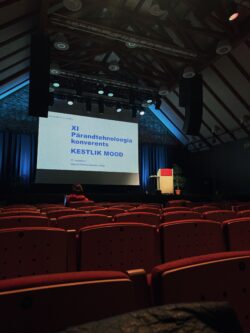
Míg a divatbemutatók önmagukban az iparág környezeti hatásának csak egy kis töredékét teszik ki, Rachel Arthur szerint a divatbemutatók a bolygót károsító túlfogyasztást tápláló marketinggépezet középpontjában állnak.
Racher Arthur tanácsadó, író és az ENSZ Környezetvédelmi Programjának fenntartható divatért felelős vezetője és az ő cikkét adjuk közre magyar fordításban.
Az elmúlt hetekben a divatszakma visszaáramlott Párizsból, a luxusipar kétévente megrendezésre kerülő női divathét utolsó és legpompásabb állomásáról.
Vásárlók, hírességek és influencerek százai repültek oda benzinfaló repülőjáratokon, hogy egy pillanatra bepillantást nyerjenek az új kollekciókba, amelyeket gondosan megmunkáltak egy olyan elavuláshoz, amely azt jelenti, hogy mindenki hajlandó lesz újra repülőre ülni, és hat hónap múlva újra megismételni az egészet.
Az biztos, hogy az ezekkel a nagyszabású marketing pillanatokkal közvetlenül összefüggő kibocsátások és hulladékok csepp a tengerben az iparág teljes lábnyomához képest. Az évek során a márkák és a divattanácsok erőfeszítéseket tettek mindkettő csökkentésére.
A bemutatók közvetlen hatására való kizárólagos összpontosítás azonban figyelmen kívül hagyja a nagyobb képet: a divat negatív környezeti és társadalmi hatásának középpontjában a túltermelés és a túlfogyasztás áll. És mit tesznek a divathetek, ha nem mindkettőt táplálják? Vegyük csak a közelmúltbeli New York-i, londoni, milánói és párizsi rendezvények sorát, nem is beszélve a gyakran túlzó módon megrendezett és elő-őszi kollekciókról – minden egyes bemutató beindít egy marketinggépezetet, amelynek célja az új termékek vásárlásának ösztönzése. Az események által inspirált trendek, az általuk biztosított médiaérték és végső soron a vásárlás, amelyre mindezek ösztönöznek, táplálják a környezeti hatásukat.
Ez a divatbemutatók úgynevezett “agylenyomata”: a kifutón való megjelenésnek a fogyasztásra gyakorolt hatása.
“Ha a lábnyomod a működésedet írja le, akkor az agynyomod azt írja le, hogy az embereket milyen érzésekkel töltöd el. Ez az Ön kulturális lenyomata” – mondta Lucy Shea, a Futerra változási ügynökség csoport vezérigazgatója.
A divatbemutatókra költött milliók nem csak a kifutó kollekciók értékesítését mozdítják elő, hanem a szomszédos és könnyebben hozzáférhető termékek – a táskáktól az illatokig – sokkal szélesebb körű fogyasztását ösztönzik, valamint a tömegpiaci másolatok iránti keresletet is.
A reklámipar felismerte ezt a dinamikát. A Purpose Disruptors, egy korábbi reklámszakemberekből álló szervezet, amelynek célja az éghajlatváltozás katalizálása, bevezette a reklámozott kibocsátás fogalmát, amely a kampányok által generált forgalomnövekedés mérésére utal. Ez azt mutatja, hogy a reklámok 32 százalékkal növelik az Egyesült Királyságban minden egyes ember éves szén-dioxid-kibocsátását.
Talán szükségünk lenne egy ezzel egyenértékű elszámolási folyamatra a divatmarketing számára. Nevezzük el “trendkibocsátásnak” – egy olyan mód, amellyel mérhető a luxus imázsépítés által vezérelt fogyasztás hatása.
Ez azért fontos, mert a divat csak akkor fogja elérni fenntarthatósági céljait, ha csökkenti az eladott termékek mennyiségét. De a luxus agynyomása – a divatbemutatóktól kezdve a szerkesztőségi fotózásokig, reklámkampányokig és influencer posztokig, amelyeket elősegítenek – jelenleg az ellenkezőjére ösztönöz, arra buzdítva a vásárlókat, hogy vásároljanak a villámgyorsan változó trendeknek
Ezt az ENSZ Környezetvédelmi Programja és az ENSZ Éghajlatváltozással foglalkozó szervezete a Fenntartható divatkommunikációs útmutatóban (Sustainable Fashion Communication Playbook) https://www.unep.org/interactives/sustainable-fashion-communication-playbook/ állapította meg. Ez egy felhívás a túlzott fogyasztás üzeneteinek felszámolására, beleértve a hagyományos divatbemutatókat is, és ehelyett a fenntartható fogyasztás irányába kell terelni az erőfeszítéseket.
Ennek nem kell a divathetek halálát jelentenie – ahogyan a fenntartható divatágazat sem követeli meg a divat teljes megszűnését. De mindkettő radikális változást igényel.
Az olyan bemutatók, ahol milliókat költenek a gazdagság pillanatnyi és extravagáns fitogtatására (mindezt azért, hogy a kapcsolódó márka- és médiaértékből további milliókat nyerjenek vissza), nem aktuálisak egy olyan időszakban, amikor iparágként hozzájárulunk a bolygórendszerek eróziójához, amelyektől a túlélésünk függ, és eközben emberek millióit sújtjuk, főként a fejlődő országokban.
Ez áll a középpontjában annak, hogy Amy Powney, a fenntarthatóságra összpontosító Mother of Pearl luxusmárka kreatív igazgatója miért nem tart többé divatbemutatókat.
“Az éghajlati összeomlás idején ez durvának és szükségtelennek tűnt” – mondta. Ehelyett arra kellene használnunk az ilyen alkalmakat, hogy támogassuk és ünnepeljük azokat, akik megmutatják, hogy másképp is lehet.
A koppenhágai divathét az alternatív megközelítés egyik példája: A tervezőknek 2023-tól 18 konkrét fenntarthatósági követelménynek kell megfelelniük ahhoz, hogy bemutatót tarthassanak. Többek között nem szabad megsemmisíteniük a korábbi kollekciók eladatlan ruháit, a bemutatott ruhák legalább felének jobb anyagokból kell készülnie, és a márkáknak vállalniuk kell, hogy platformjaikat a vásárlók oktatására és tájékoztatására használják a fenntarthatósági gyakorlatukról. Bár van még hova fejlődni, más nagyvárosokkal összehasonlítva ez egy nagy nyilatkozat.
Most azokra van szükségünk, akik ismét nagyobb léptékben gondolkodnak arról, hogyan mutassuk be a divattal való kapcsolat új módjait. Végül is ez már nem a fokozatos változás ideje. Az átalakulást fel kell turbózni, új rendszereket és üzleti modelleket kell kifejleszteni – olyanokat, amelyek nem arra épülnek, hogy egyszerűen egyre több és több új dolgot adnak el, és nem gondolnak az emberekre, a bolygóra, sőt a profitra gyakorolt hosszú távú hatásokra. A divatbemutatók újragondolása ennek része.
A divat maga is felismerte a változás szükségességét. A világjárvány idején az iparágon belül egyre többen kérték, hogy reformálják meg a divathetek könyörtelen forgását, ami a független tervezők számára pénzügyileg bénító lehet.
Ahelyett, hogy a platformok egy elavult, elromlott rendszert táplálnának, a divatheteknek lehetőséget kellene adniuk egy új rendszer elképzelésére. A márkáknak arra kellene használniuk őket, hogy rávilágítsanak a megoldásokra, valamint hogy felemeljék és ösztönözzék a tudatos fogyasztás körüli törekvéseket. Erre már vannak példák. Az idei szezonban Párizsban Stella McCartney a kifutón tartott bemutatóját az alacsonyabb környezeti terhelésű anyaginnovációk piacával egészítette ki. New Yorkban Maria McManus tervező a bemutató végeztével a közönséggel együtt végigvezette, hogyan készültek az egyes darabok a fenntarthatóság jegyében.
Ünnepeljük azokat is, akik a körforgásos megoldásokat helyezik előtérbe; azokat, akik a hulladékot erőforrássá alakítják, és arra ösztönzik a fogyasztókat, hogy szeressenek bele az olyan fogalmakba, mint a használt és újrahasznosított divat. Egy párizsi divathét csereboltja, amelyben a szokásos első soros versenyzők is részt vennének, nem csak hatalmas nyilatkozat lenne, hanem talán az egyik legnagyszerűbb divatbemutató, amelyet a mai divatipar valaha is látott.
Itt van egy kreatív lehetőség arra, hogy az ember használja az agylenyomat erejét, és új utat kovácsoljon. Bár a kreativitást nem szabad korlátozni, azt feltétlenül át kell irányítani.

